What’s for Dinner?
Unit Six: Help Yourself to…
6.1. What’s for Dinner?
Word Bank | Phrase Bank | Communication Box |
To chew Steak To smell Cabbage rolls Mixed salad Appetizers Rare | To be hungry as a hunter To taste like nothing Else on earth To have a three-course dinner To be full of vitamins to be low in calories to have a sweet tooth to be stuffed with something | Frankly, … I bet, … For dessert, … … at last! It’s time for… > |
I. Conversational Warm-up.
Look and say what dishes are popular in your country. When do you have them?
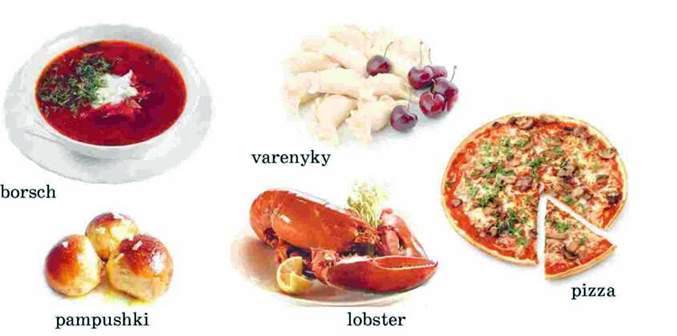
Example: Borsch is popular in Ukraine. I often have it for dinner.
II.
Read and practise the sounds /аі/ and /v/. Answer the questions of the chant.
DINNER CHANT
– What’s for dinner?
What’s for dinner?
What’s for dinner tonight?
– I’m making your favourite. Do you want a bite?
– Thank you, I do.
– Does it taste all right?
– I’m chewing, and chewing, And chewing, and chewing.
– Don’t you like your steak? Don’t you love your grandma?
– I love you, grandma,
But the steak is rare.
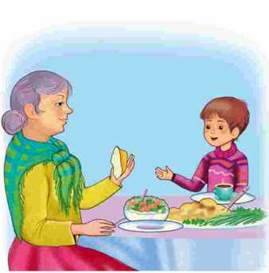
III. Grammar Smart.
1. Look and recall!
Use yes/no questions to get a short answer. Begin with: Do you…? Are you… ? etc.
Example: – Do you like tea?
– Yes, I do. / No, I don’t.
Use yes/no questions to express surprise. Begin with: Don’t you… ? Aren’t you… ? etc.
Example: Don’t you like your steak? (Хіба тобі не подобається біфштекс?
A) Let’s play a grammar chain game.
Example: Ann: Do you like pizza?
Steve: You like pizza, don ‘t you?
Helen: Don’t you like pizza?
B) Ask your friend if she / he likes:
– cheese – varenyky – steak
– sausage – hamburger – ice cream
– borsch – Coca-Cola
2. Read and remember!
Use a lot of with countable and uncountable nouns to talk about a large amount of food in positive and negative sentences:
Example: We haven’t got a lot of potatoes left. (coun table)
We’ve got a lot of orange juice, (uncountable)
Use a little with uncountable nouns to talk about a small amount of food: Example: Add a little butter to the porridge.
A) Play a grammar chain game.
Example: A: We haven’t got a lot of cheese.
B: True. We have got a little cheese.
B) Tell your friend about the amount of food you have got / haven’t got at home as in the example.
Example: We have got a lot of apples at home.
We haven’t got a lot of bread left.
We have got a little ice cream left.
VI. Word Smart.
1. Study these words and word-combinations and speak about: a) the eating habits in your family.

Example: Traditionally, we have a three-course dinner.
B) your mum’s cooking style.
Varenyks; | To be stuffed with something; | Meat dumplings; |
Cabbage rolls; | Mixed salad; | Appetizer. |
Example: My mum often cooks meat dumplings for dinner.
3. Look at the photos and say what different family members enjoy having for dessert.
Example: I think the mother enjoys a cup of coffee for dessert.
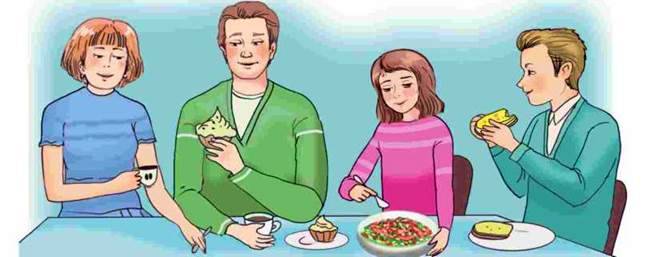
At home: Describe yesterday’s dinner menu with your family.
Go to Ex. 85, 86 of your Workbook
V. Time to Listen and Read
1. Listen to / read the description of the typical dinner menu in Lucy’s home and say if it is different from yours. Use the text below.
DINNER WITH LUCY’S FAMILY
Classes are over at last! It’s time for dinner. Frankly, I’m hungry as a hunter. I can smell mum’s tasty borsch even from a distance. Do you happen to know that my mum is the world’s best cook?! She is especially good at cooking Ukrainian dishes, such as: varenyks, halushkas, cabbage rolls, pancakes and what not. Her mixed salad tastes like nothing else on Earth.
I bet, we’ll have a three-course dinner today. As usual, it will start with appetizers, like cucumber or cabbage salad, ham or sausage, cheese or smoked fish. I’ll certainly choose vegetables – they are full of vitamins and low in calories. For the first course it will be my mum’s speci>
Here I am at home. What’s for dinner, mum?…

2. Answer the questions.
1. What did Lucy’s mother cook for the first course?
2. Why does Lucy prefer vegetables, to begin with?
3. What do they usually have for the main course?
4. Who has a sweet tooth in Lucy’s family?
5. Lucy’s mother is good at cooking traditional Ukrainian dishes, isn’t she?
3. Complete the sentences about Lucy’s family dinner and compare it to yours.
Example: Lucy has… . -” Lucy has a three-course dinner. Me too.
1. Lucy’s dinner starts with… .
2. Lucy chooses….
3. For the first course… .
4. The main course often consists of… .
5. >
6. For dessert, ….
VI. Time to Communicate:
1. Act as Lucy and describe your dinner. Use the text “Dinner with Lucy’s Family”.
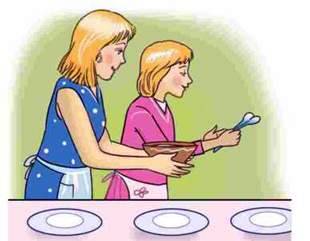
– appetizers;
– to taste like something;
– to serve with garlic;
– for garnish;
– to finish with.
2. In pairs, discuss the dinner menu in your families.
A: It’s dinner time. Are you hungry?
B: … .
A: You usually have a three-course dinner, don’t you?
B: … .
A: I bet, you start with appetizers.
B: … .
A: Don’t you have a sweet tooth?
B: … .
3. Speak about a traditional Ukrainian dinner.
VII. Time to Listen.
Listen to the joke about a good cook and say why she refused the new job.
VIII. Time to Write.
Write your favourite dinner menu. Follow the format below (p. 159).
DINNER MENU
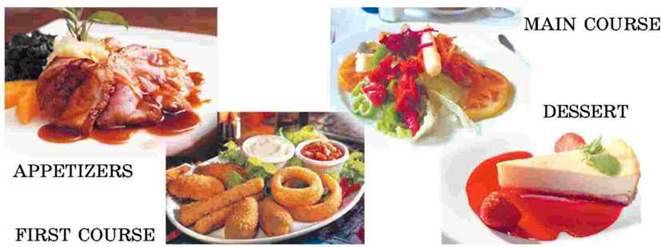
Go to Ex. 87, 88 of your Workbook